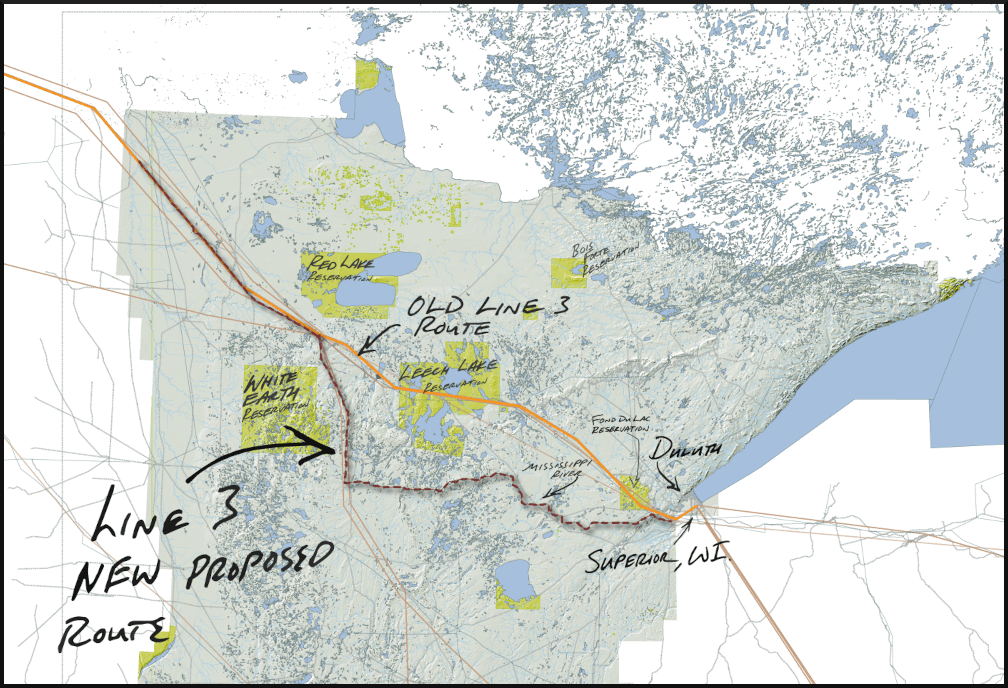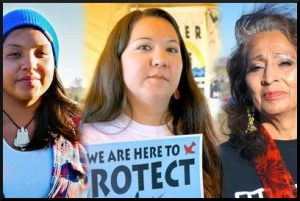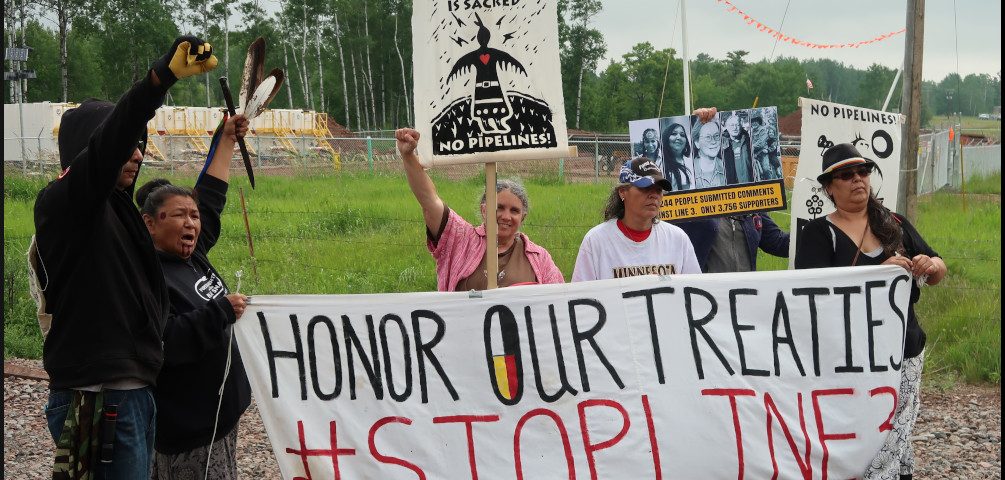by Bronwen AE, published on Socialist Action, April 19, 2021
The Biden Administration announced in early April that it will NOT force the Dakota Access Pipeline (DAPL) to shutdown despite an order by U.S. District Judge James E. Boasberg to complete his court-ordered Environmental Impact Statement. In Standing Rock Sioux Tribe et al. v. U.S. Army Corps of Engineers et al., Boasberg had ruled that the previous government Environmental Impact Statement was “incomplete.”
President Biden adhered to his campaign pledge to cancel the Keystone XL pipeline which was slated to transport tar sands oil from Alberta, Canada to the U.S. Tar sands are a mixture of sand, clay, and water, soaked with bitumen, a dense and carbon-intensive form of petroleum.
But Enbridge Corporation’s Line 3 Pipeline is being constructed in Northern Minnesota across sacred Anishinaabe Tribal land to transport tar sands oil. The Biden Administration’s decision to allow the DAPL pipeline to operate despite an incomplete assessment of its environmental impact sends a mixed message to indigenous rights, environmental and climate change activists even though DAPL doesn’t transport tar sands. The struggle against all these pipelines, rooted in Native American treaty rights and Constitutional Amendments protecting Native American culture/land, drew International attention beginning five years ago.
Water Protectors
Activists doing direct action against the pipeline companies became known as “WATER PROTECTORS” and the pipeline(s) became known as the “BLACK SNAKE.” Indigenous Youth Water Protectors held a rally at the Army Corps of Engineers (ACE) headquarters in Washington, D.C. on April 1 commemorating the five-year anniversary of the Sacred Stone Camp on the Standing Rock Sioux Reservation and demanding that the Biden Administration “STOP PIPELINES” and “BUILD BACK FOSSIL FREE.” This demand to “STOP PIPELINES” included the Line 3 pipeline which Enbridge began constructing in December 2020 after Minnesota Governor Tim Walz signed all the required permits in mid-November. Minnesota 5th District Rep. Ilhan Omar, who has urged President Biden to STOP LINE 3, describes Line 3 as “a proposed tar sands pipeline project that involves the deployment of 330 miles of new pipeline.”

According to Winona LaDuke, Ojibwe-White Earth Tribe, Native American rights activist, environmentalist and founder of Honor the Earth, the struggle in Minnesota against Enbridge’s construction of Line 3 has been going on for seven years. LaDuke states in an interview in Minnesota Women’s Press (April 2021):
“When Enbridge comes in, there are big bulldozers, excavators, backhoes, and people that walk through the forest beheading trees before they come back for the rest. They are coming for the rivers” … “They plan to shove in a 36-inch pipe, so it can move 915,000 barrels a day of the dirtiest oil in the world across 337 miles of Northern Minnesota to Lake Superior. All for a dying industry.”
Big oil threatens Anishinaabe people
The predominantly women-led Indigenous Water Protectors battle against the “Black Snake” is the epitome of anti-imperialist struggle in North America. The survival of the Anishinaabe people is being threatened by big oil companies and colonizer dependence on fossil fuels. The Anishinaabe are a “group of culturally related Indigenous people resident in what are now called Canada and the United States” The Anishinaabe includes the Ojibwe (Chippewa) of Northern Minnesota who were forcefully relocated to the Midwest by the United States government. In “Recovering the Sacred: The Power of Naming and Claiming”, Winona LaDuke explains that Manoomin, also known as wild rice, is sacred to the Ojibwe because it is a gift to the Anishinaabeg from the Creator. When the US relocated the Anishinaabeg to the Midwest, the Creator told them to look for the Manoomin, “the food that grows on the water,” and that when they found it that it would indicate the end of their migration. In the film, First Daughter and Black Snake, Ms. LaDuke states emphatically:
“The [Line 3] pipeline proposal would go across our food. Our wild rice is our most sacred food. Our berries are sacred. Our maple sugar bush is sacred to us. This pipeline would change the terrain and threaten our food.”
Treaty rights violated
When Minnesota Governor Tim Walz signed all of the permits that Enbridge required to proceed with construction on its Line 3 Pipeline Project, he did so first, knowing that the Line 3 Pipeline would violate the treaty rights of the Ojibwe Tribes of Minnesota and second, knowing that an Enbridge pipeline had already caused one of the worst oil spills in U.S. history when one of their pipelines “burst” and spilled between 877,000 and 1 million gallons of tar sands oil into the Talmadge Creek, a tributary of the Kalamazoo River in Marshall, Michigan near Grand Rapids, Minnesota in 2010. Winona LaDuke again details this atrocity of Gov. Walz granting permission for the Enbridge Line 3 pipeline in an interview with Amy Goodman on Democracy Now by declaring:
“I mean, they don’t have a spill plan for Lake Superior. They couldn’t meet the water quality standards. And their need projections were based on what Enbridge wished need be, not the reality of decreased demand for oil”.
One day after Gov. Walz approved the permits for the Enbridge Line 3 Pipeline Project, Michigan Governor Gretchen Whitmer revoked the easements for Enbridge Line 3 underneath the Straits of Mackinac, citing the Public Trust Doctrine.
Tara Houska, Ojibwe-Couchiching First Nation, is an indigenous lawyer, climate activist and founder of the Giniw Collective of Water Protectors. In a November 25, 2020 interview with Amy Goodman on Democracy Now, Goodman asked her, “And what about the counterinsurgency issues that have been raised?” Houska’s response revealed the ongoing struggle with militarization that Native Americans have endured since European colonization of North America and which becomes more public in their efforts to stop pipelines, similar to the way in which police brutality has always existed in oppressed communities of color but became more visible after the police murder of George Floyd in Minneapolis. Houska replies:
“I’m not sure what the Public Utility Commission thinks counterinsurgency is because we’ve already been heavily surveilled. There have been reports of Customs-Border Patrol drones that we’ve seen over our encampment and private land. We knew that was happening. There are people that are surveilling and targeting individual citizens, including myself, including others that have been leaders in this particular fight. There’s militarization of law enforcement all along the line, purchases of riot gear, bringing in of MRAP’s and all kinds of other militarized force I can only presume has to do with the Line 3 struggle.”
Environmental racism
In February, Rep. Ilhan Omar met with Indigenous Activists, aka “Water Protectors”, at their Stop Line 3 encampment in Northern Minnesota. Rep. Omar described Enbridge’s Line 3 as “environmental racism” and described the areas impacted as “a thousand acres of wetlands and 211 water bodies”. The activists who participated in Rep. Omar’s Listening Session stated that Enbridge’s Line 3 is genocidal for the Ojibwe of Northern Minnesota as it is likely to destroy their food supply. Tara Houska described it as “cultural genocide” and said that “Line 3 is a 10% expansion of the tar sands. Line 3 is fifty coal plants in emissions.” In a more recent discussion hosted by Rep. Omar, “Stop Line 3” activists described a situation for the Ojibwe Tribes and citizen’s groups who have filed legal appeals for what
 Winona LaDuke describes as, “every step of the process, including the Certificate of Need and the Route Permit that was issued by the State of Minnesota” that is like the legal battle to Stop the Dakota Access Pipeline that the Biden Administration refused as of today. Environmental activists describe the goal of Enbridge as the completion of construction of the Line 3 Pipeline Project prior to the advancement of tribal and environmental groups appeals in the courts. This means that what is necessary to Stop Line 3 is the continued direct action of the Indigenous Water Protectors and ally land protectors such as the locking of machinery and physical barriers to its’ construction in order to slow down Line 3 construction allowing for those appeals to be heard in court.
Winona LaDuke describes as, “every step of the process, including the Certificate of Need and the Route Permit that was issued by the State of Minnesota” that is like the legal battle to Stop the Dakota Access Pipeline that the Biden Administration refused as of today. Environmental activists describe the goal of Enbridge as the completion of construction of the Line 3 Pipeline Project prior to the advancement of tribal and environmental groups appeals in the courts. This means that what is necessary to Stop Line 3 is the continued direct action of the Indigenous Water Protectors and ally land protectors such as the locking of machinery and physical barriers to its’ construction in order to slow down Line 3 construction allowing for those appeals to be heard in court.
Non-violent direct action
According to a March 26th Democracy Now headline story, “In Northern Minnesota, witnesses say police arrested more than two dozen water protectors Thursday as they took nonviolent direct action to stop construction of Enbridge’s Line 3 Pipeline” …
“Construction crews were idled Thursday for more than four hours after land defenders locked their arms together as Indigenous water protectors sang and prayed.”
Winona LaDuke’s requests of the Biden Administration are like those of the Indigenous Youth Water Protectors to
“Build Back Fossil Free.” She says, “Let’s move on. Time to move on. Let’s quit fighting over rocks and pipes and let’s move into something where we have an economy based upon peace, respect and justice.”
*Featured Image: Just over a dozen self-proclaimed water protectors gathered at the Wisconsin-Minnesota state line south of Superior to vow they will prevent the line from crossing the border Friday, June 29, 2018. ~Danielle Kaeding/WPR
